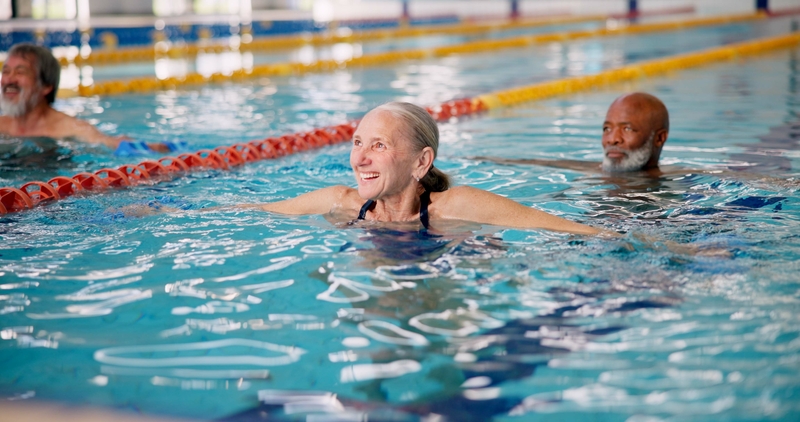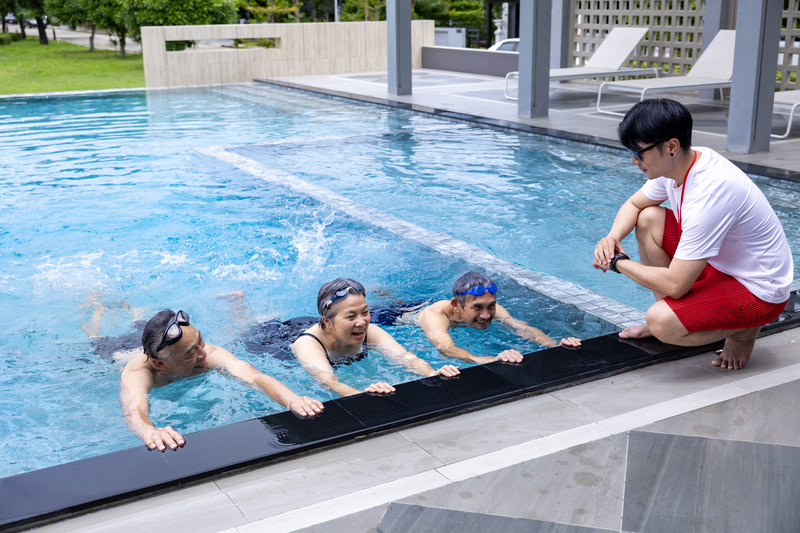Make a Splash! Summer Fun for Toning Up

The sun’s out, the water’s warm, and it’s the perfect time for swimming. You might not think of swimming for fitness as a huge health booster since it’s so fun, but you may be surprised at just how much this enjoyable activity can bolster your levels of fitness and health.
What Are the Benefits of Swimming?
You may have noticed that you tend to float when you’re in the water. This fact alone makes it the perfect medium for gentle exercise without putting a whole lot of stress on your body. Because the surrounding water supports your body weight, it takes pressure off joints, tendons, ligaments, and muscles. You’re not forced to hold your body upright or stand on injured areas. The water lifts you up and, at the same time, allows you to move through resistance in any direction.
There are a lot of studies that tout the many benefits of swimming. From cardiovascular benefits to muscle strength and fat loss, swimming for fitness is one of the best exercise choices you can make.
What are some of the benefits that swimming provides? Let’s count the ways:
- It strengthens your heart and lungs—swimming is a great workout! Swimming for fitness by doing some laps will wear you out and get you in shape.
- It works around joint issues—since you’re not putting any direct weight on your joints, you can use the support of the water as your resistance as you move through various strength and mobility exercises.
- It improves your circulation—just the fact that you’re able to move your limbs around will aid in improving your circulation.
- It burns tons of calories—being in the water will have you burning off body fat like crazy. Not only does your body need to up your metabolism to stay warm in cooler water, but moving through the resistance that water provides forces you to burn extra calories as well. Swimming, for the most part, is a whole-body exercise, and the more muscles that are engaged, the more calories you burn.
- It strengthens muscles—another great benefit of swimming for fitness is that water provides a lot of resistance, which helps strengthen muscles over time. The faster you move, the greater the resistance provided, the harder the workout, and the more strength you’ll gain.
- It’s injury-friendly—swimming is wonderful for those who are nursing injuries and who can’t do many exercises. In the water, your limbs are supported, and you don’t need to worry about falling or balancing. The water cradles your body and lets you perform pushing and pulling movements without making injuries worse.
- It boosts immune function—swimming helps lower stress levels (it might even get you laughing), which, in turn, helps your body’s immune system.
- Swimming is fun—whether you’re at a pool or at the beach, swimming fosters camaraderie and family fun, allowing for plenty of feel-good hormones to be released.
Try Some of These Swimming Exercises
Always start slowly when you’re doing a new exercise. If you’re not acclimated to tough workouts, you might need to start in the shallow end or brace yourself against the wall of the pool. Once you begin to get stronger (or if you’re already there), you can make your workouts tougher by using a kickboard, waterproof weights, and even hand paddles. The possibilities are endless!
Here are a couple of basic moves to get you started:
Walking through water—this may be the number pick when it comes to the most gentle yet effective workouts you can do. If you’re a beginner, start by walking through water that comes up to your knees. Once you get stronger, ramp up the workout by going a little deeper each time. For the ultimate water-walking workout, submerge your body, just keeping your head above water.

Flyes and reverse flyes—start by standing in water that comes up to your shoulders. Bring your arms up straight and out to your sides, hands and fingers splayed. Next, squeeze your chest muscles to bring your arms forward until your hands touch. Pause and then reverse the movement, pushing your arms backward as far as you can. This will engage the muscles in your back. Repeat five repetitions in each direction and then rest.

Scissor kicks—start against the edge of the pool with your arms on the pool edges at each side of you. Lift your legs off the ground and keep them straight as you go through the scissor kick motion. Continue for 60 seconds; then rest and repeat.

Studies have shown that after just 12 weeks of a water aerobics program, those who exercised at least twice a week for 50 minutes at a time showed vast improvement in not only strength and body fat ratios but also in blood pressure and cardiovascular fitness. With all the improvements to your heart, your muscle strength, and your body composition, why not make swimming for fitness a regular part of your exercise routine?





